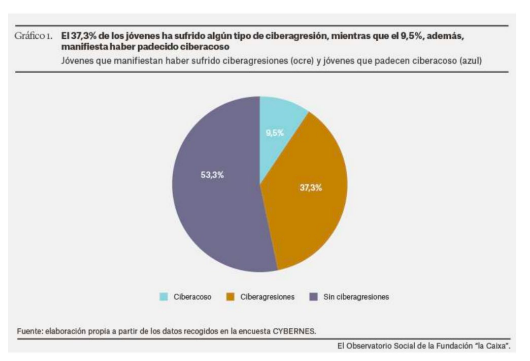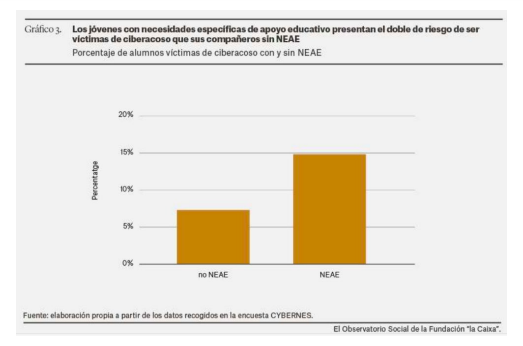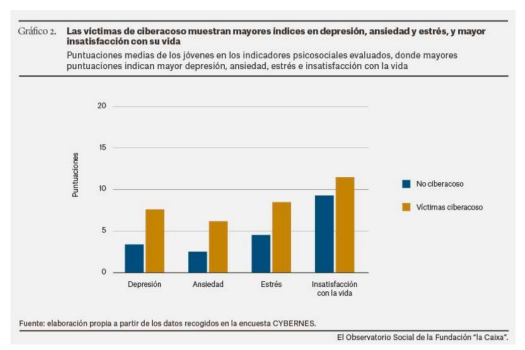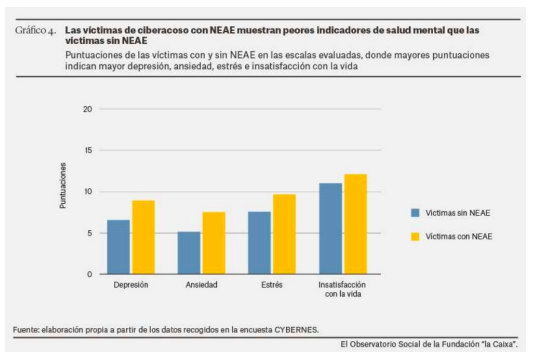Four out of five victims are not aware that they are being cyberbullied

Cyberbullying or cyberharassment is defined as aggressive and intentional behaviour that occurs repeatedly (at least once or twice a month) against a person who cannot easily defend themselves in a context such as the digital one. Based on this premise, four out of every five victims are unaware that they are suffering cyberbullying, according to a study by the Social Observatory of the "la Caixa" Foundation.
The research project Young people with specific educational support needs suffer twice as much from cyberbullying, from the 2021 call to support social research on technology and society, also yields another outstanding fact: practically half of the young people surveyed had suffered some kind of cyber-aggression during the two months prior to their participation in the study, with cyber-aggression being understood as behaviour by people who use communication technologies, such as social networks, e-mail or text messages, to attack other people. When cyberaggressions meet certain criteria, cyberbullying is considered to be occurring.
To reach these conclusions, the researchers who led the study, Àngels Esteller Cano, Albert Flexas, Eva Aguilar Mediavilla and Daniel Adrover Roig, from the Institute for Research and Innovation in Education (IRIE) at the University of the Balearic Islands, surveyed 2,400 Spanish adolescents aged between 12 and 17, mostly students in compulsory secondary education, between March and June 2022.
The study focused on examining how technological advances and the growing dominance of the virtual environment can influence youth cyberbullying, with particular emphasis on the effects on victims with specific educational support needs (SEN).
In this regard, the principal investigator of this study, Àngels Esteller Cano, explained that "cyberbullying is receiving increasing attention among researchers, but few studies focus on students with specific educational support needs. This study aims to fill this gap by examining the involvement and consequences of cyberbullying in young people with specific educational needs.
Specific educational needs include aspects such as physical, cognitive or sensory disabilities, and speech, language and communication difficulties, such as language disorder or autism spectrum disorder. Learning and attention disorders, such as dyslexia or attention deficit hyperactivity disorder (ADHD), or high abilities are also included.
Offensive words or insults on the internet, the most frequent cyber-aggression
Through the results of the surveys, the researchers have observed that 46.8% of young people say that they have experienced some kind of violence and harassment by cybernetic means in recent months, as shown in the following graph. In particular, 37.3% of young people said they had experienced some form of cyber-aggression on an occasional basis, while 9.5 % reported having experienced cyber-bullying.

Reported cyber-aggressions include receiving offensive words or insults online (this being the most frequent cyber-aggression), being ignored or excluded from a social network or chat room, or having received threats via computer or mobile phone.
Young people's perception of cyberbullying
After answering the questionnaire on cyberbullying, the researchers provided the young people with a definition of cyberbullying and then asked them whether they thought they had experienced it in the last few months. Only 21% of the victims answered yes.
This data from the study shows that young people's perception of being cyberbullied is low, because 4 out of 5 victims are not aware of being cyberbullied. In terms of gender, males report a higher prevalence of being cyberbullied, 10.9% compared to 8% of females.
"This could indicate several things, such as that victims have normalised the situation, downplaying its importance, or that their perception is biased by personal or contextual characteristics", says Albert Flexas, co-author of the study.
Students with SEN are twice as likely to be cyberbullied
In the pre-research phase, the authors noted that few studies on cyberbullying focused on victims in educational settings with specific educational support needs (SEN). Therefore, they also analysed this variable in the respondents' answers. Thus, 28.4 % of the sample reported having some kind of SEN, such as attention deficit hyperactivity disorder (ADHD), developmental language disorder, learning disability or high abilities.
When looking specifically at the involvement of these young people as victims of cyberbullying, it was found that they are twice as likely to be cyberbullied (almost 15 %) as their peers without SEN (7.3 %), as shown in the graph below.

Mental health indicators and cyberbullying
Research on the phenomenon of cyberbullying suggests that, similar to the traditional context, cyberbullying victimisation is associated with multiple negative consequences, including poor academic performance, learning difficulties, anxiety, depression, substance abuse or self-harm.
In this sense, another of the conclusions drawn from the study by the Social Observatory of the "la Caixa" Foundation is that young people who have shown signs of having suffered cyberbullying also have worse psychosocial indicators.
Specifically, victims have shown almost twice as many depressive symptoms (7.6% of victims, compared to 3.4% of young people who have not suffered this situation), anxiety (6%, compared to 2.5%) and stress (8.5%, compared to 4.5%). These young people also showed a lower overall judgement of satisfaction with their life. On this point, 13.7% of young victims of cyberbullying show dissatisfaction with life, compared to 9% of those who have not been cyberbullied, as shown in the graph below.

When delving deeper into mental health indicators, researchers have perceived that young people who are victims of cyberbullying and, in addition, have some kind of SEN, show worse results than victims without these problems.
The researcher Eva Aguilar Mediavilla, co-author of the study, explains that the fact that "victims of cyberbullying show greater anxious-depressive symptoms is a result found in previous literature. However, students with specific educational support needs also have to face difficulties in their educational performance, which could increase this emotional distress".
The graph below shows that 9 % of cyberbullying victims with SEN suffer from depression, compared to 6.5 % of victims without SEN. Anxiety and stress symptoms are 7.5% and 9.6% respectively among victims with SEN, compared to 5.0% and 7.5% among those without SEN. Finally, dissatisfaction with life is around 15% among victims with SEN compared to 11% among victims without SEN.

Social support and resilience reduce the negative impact of cyberbullying
The authors of the "la Caixa" Foundation study also wanted to examine possible solutions to lessen the negative consequences associated with cyberbullying. Among the possible strategies that can help reduce depression, anxiety, stress and dissatisfaction, two were identified as the main ones: the search for social support and the ability to solve problems.
The first of these can involve anything from asking for advice and receiving help from a family member or friend, to talking to a teacher to share the situation and the concerns generated. The second option, resilience, refers to thinking of solutions to overcome the problem and prevent it from happening again. In contrast, researchers do not consider avoidance strategies, such as distancing oneself from the situation, pretending that nothing has happened or refusing to think about it, to be effective.
In this sense, Àngels Esteller, co-author of the study by the Social Observatory of the "la Caixa" Foundation, stresses the importance of prevention: "We are seeing the terrible psychological and social consequences of cyberbullying. Therefore, we must prioritise awareness-raising measures to prevent any child or adolescent from having to go through this".
For his part, researcher Daniel Adrover highlights the role of families and schools, and maintains: "Families and institutions must work together to teach (and learn) how to communicate situations of bullying and cyberbullying, providing tools that allow us to understand the situation and face it with guarantees of overcoming it". "Among other things, it is essential to have a protocol for action and intervention in situations of bullying and cyberbullying at school, and to act in accordance with it", he concludes.
The Social Observatory of the "la Caixa" Foundation
The aim of the Social Observatory of the "la Caixa" Foundation is to provide diagnoses of the social reality in the areas of knowledge related to the "la Caixa" Foundation's main areas of action: social, educational, cultural and research.








